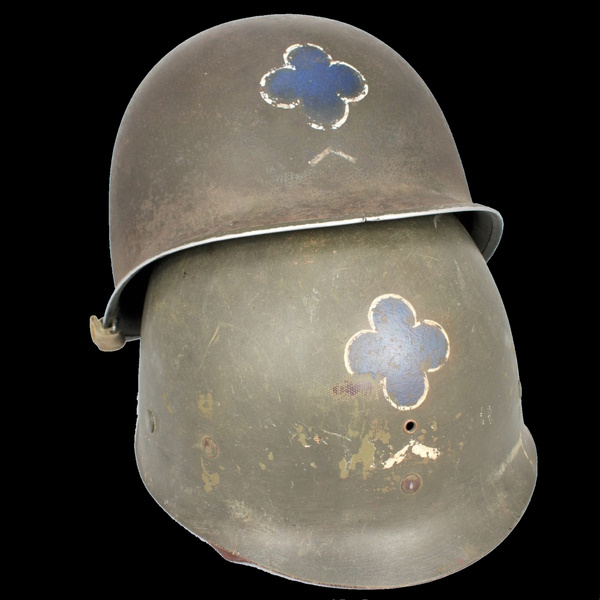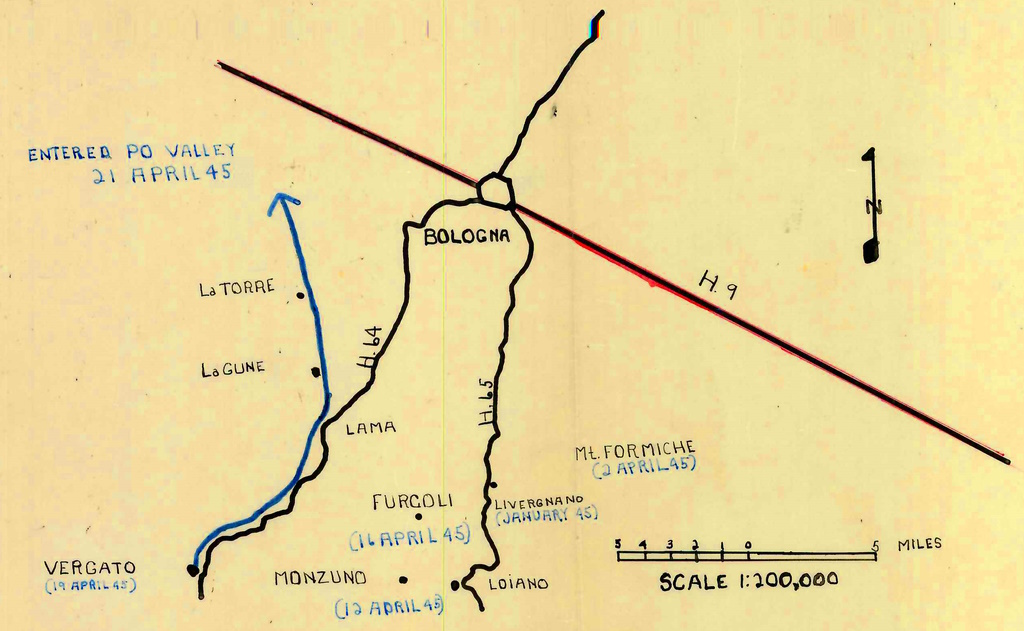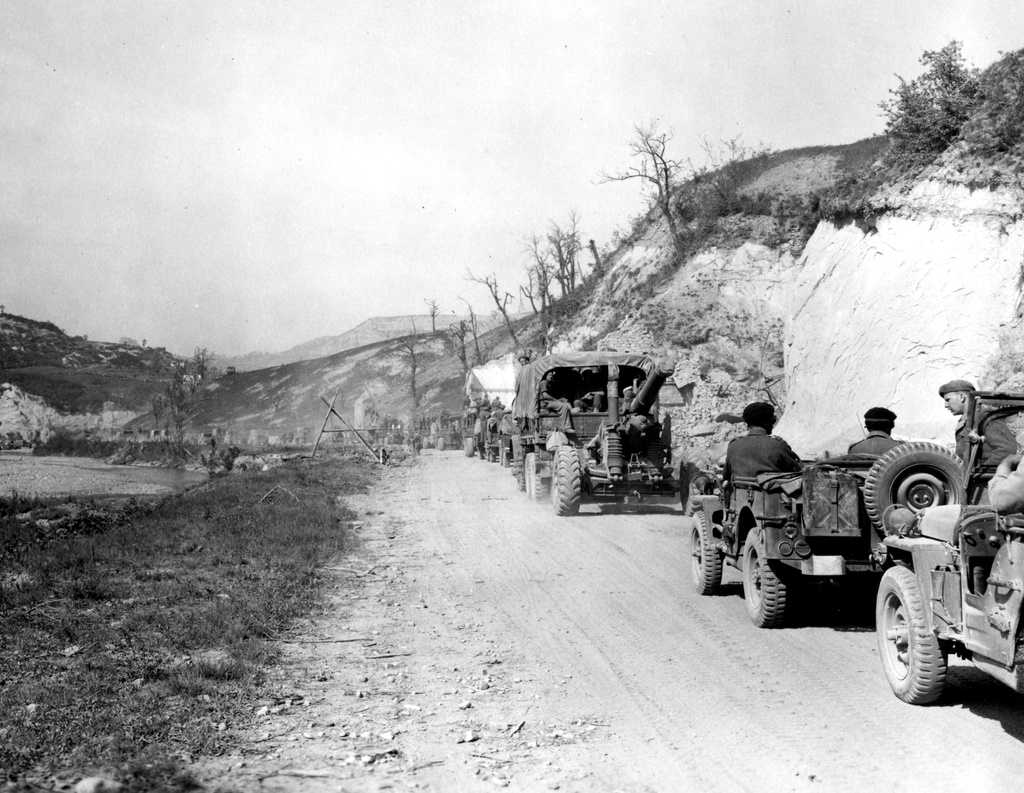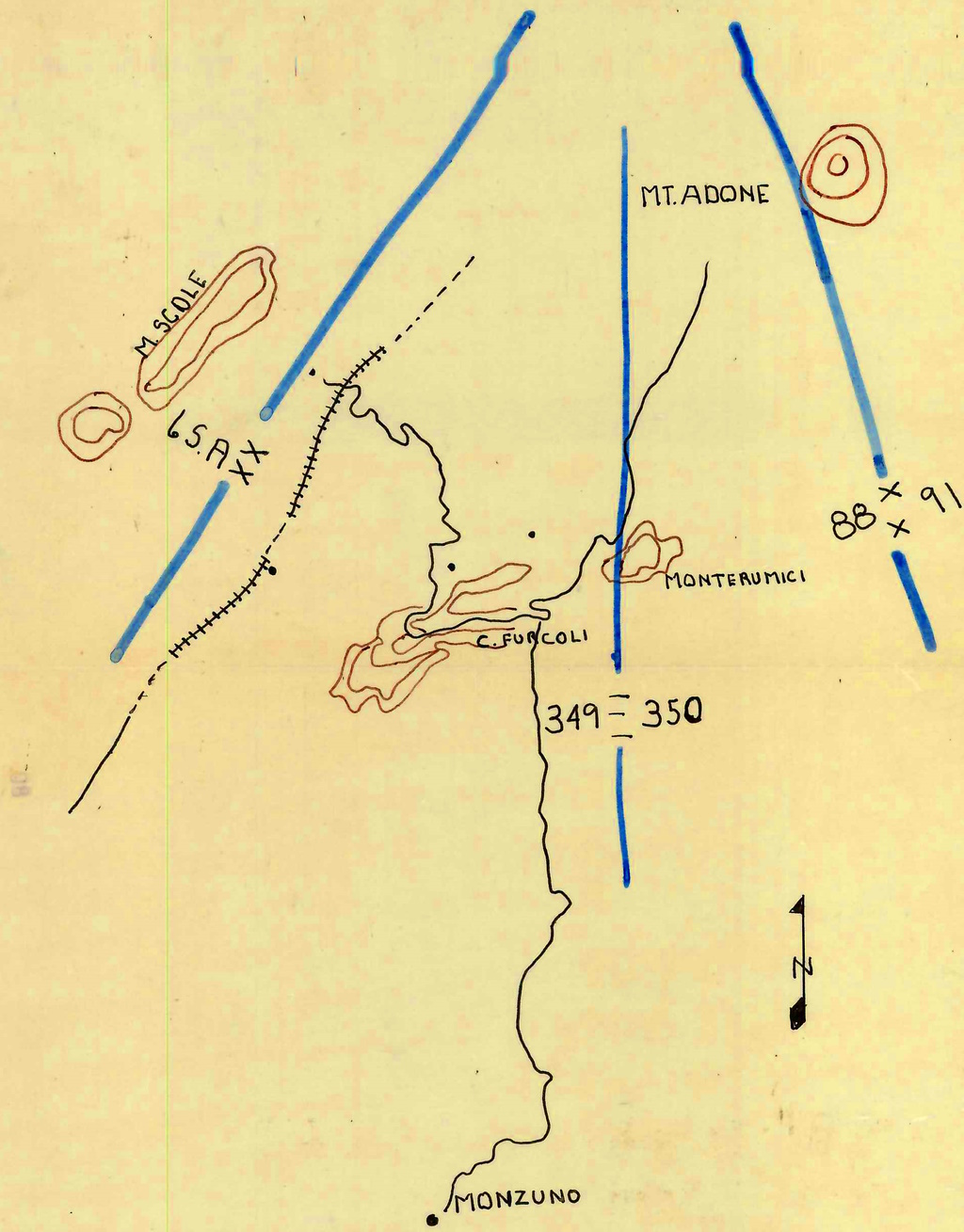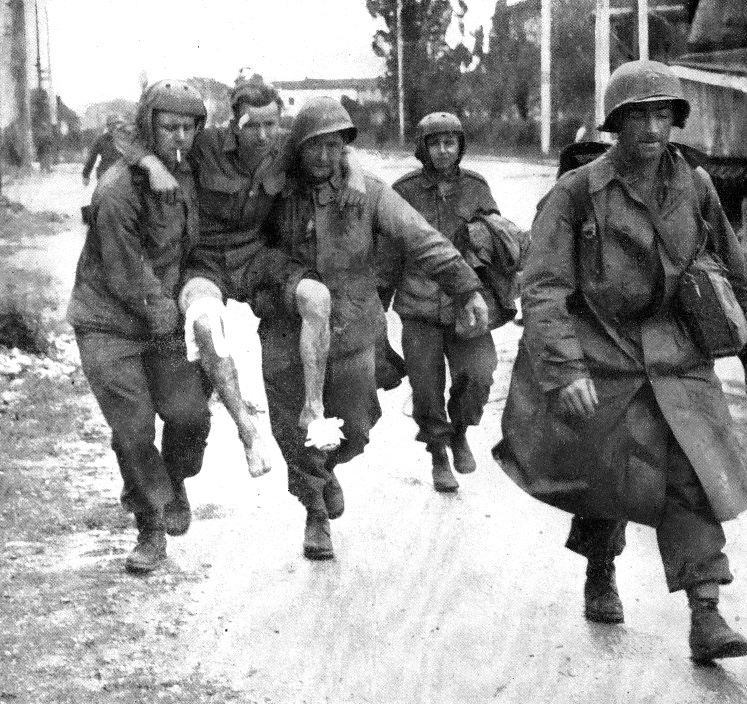Document Source: Infantry School, General Section, Military History Committee, Fort Benning, Georgia, Advanced Officers Course (1946-1947). Operations of the 2nd Battalion, 349th Infantry Regiment, 88th Infantry Division, in the Breakthrough and Pursuit to the Po River, April 15-24, 1945. Personal Experience of a Company Commander, Capt Paul R. Behnke, Infantry

This archive covers the operation of the 2nd Battalion, 349th Infantry Regiment, 88th Infantry Division, in the attack of the German line at Furcoli-Monterumici, Italy, April 15-24, 1945, the breakthrough and the pursuit of the enemy to the Po River which was reached on April 24, 1945. To orient the reader properly I would like to return to the month of January 1945 and give a short resume of the events that led to the final and decisive action of the battalion that marked the turning point of the Italian Campaign.
During the latter part of January 1945, the battalion was in a position just east of Highway 65 near the town of Liverngino. The personnel of the battalion at this time consisted of about fifty percent replacements most of whom had seen no offensive combat, having reached the division too late to join in the action of the fall and winter 1944 in which, during a 52-day period, the division had suffered some 9000 casualties. The rest of the command were veterans many of whom had nearly a year of combat to their credit and who had returned to the battalion during the quiet months of December 1944 and January 1945. Since the stop of the drive in 1944 the only offensive action of the battalion had been in patrols, but this had been nearly a nightly affair, and in the opinion of this writer that is one of the most difficult types of activities to engage in over a long period of time. Due to the condition of the troops, the decision was made to pull the division from the line for a short rest period, to be followed by a very intensive training period, which was to stress small unit training over the type of terrain that the spring push would bring this was done during the month of March 1945.

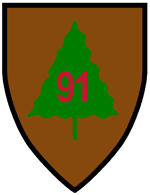 At the close of the training period, on April 1, 1945, all units were ordered to black out, (This consisted of removing the insignia from all clothing and equipment and covering the bumper markings of all vehicles with a heavy coat of grease) and prepare to move back into the lines. On April 2, 1945, the 2nd Battalion was attached to the 91st Infantry Division and moved into positions near Monte delle Formiche, the remainder of the regiment being in reserve attached to the 34th
At the close of the training period, on April 1, 1945, all units were ordered to black out, (This consisted of removing the insignia from all clothing and equipment and covering the bumper markings of all vehicles with a heavy coat of grease) and prepare to move back into the lines. On April 2, 1945, the 2nd Battalion was attached to the 91st Infantry Division and moved into positions near Monte delle Formiche, the remainder of the regiment being in reserve attached to the 34th  Infantry Division. Note: the above-mentioned move was purely a screening action to assist in deceiving the enemy. During this period all of the Company Commanders of the regiment had an opportunity to make an aerial reconnaissance of the terrain behind the enemy lines over which the attack was to be launched, and on April 12, the regiment was consolidated and moved into an assembly area near Monzuno.
Infantry Division. Note: the above-mentioned move was purely a screening action to assist in deceiving the enemy. During this period all of the Company Commanders of the regiment had an opportunity to make an aerial reconnaissance of the terrain behind the enemy lines over which the attack was to be launched, and on April 12, the regiment was consolidated and moved into an assembly area near Monzuno.

 Field Order No. 1, Headquarters, 349th Infantry, April 11, 1945, gave the plan of attack. The II Corps was to attack with four Divisions on line. The 34th Infantry Division on the right was to capture Bologna, and the 91st Infantry Division on the center-right was to capture Monte
Field Order No. 1, Headquarters, 349th Infantry, April 11, 1945, gave the plan of attack. The II Corps was to attack with four Divisions on line. The 34th Infantry Division on the right was to capture Bologna, and the 91st Infantry Division on the center-right was to capture Monte  Adone. On the left, the 6th South African Armored Division was to seize Monte Scole, on the center-left
Adone. On the left, the 6th South African Armored Division was to seize Monte Scole, on the center-left  was the 88th Infantry Division who was attacking with two regiments abreast, and on the right, the 350th Infantry was to capture the key terrain feature of Monterumici. For the 349th Infantry, a sector was indicated that was bounded on the right by Monterumici and on the left by Highway 6620.
was the 88th Infantry Division who was attacking with two regiments abreast, and on the right, the 350th Infantry was to capture the key terrain feature of Monterumici. For the 349th Infantry, a sector was indicated that was bounded on the right by Monterumici and on the left by Highway 6620.
 The plan called for the 3rd Battalion to launch a company strength raid in feint toward the town of Vado, while the 1st Battalion with Fox Co attached was to attack the town of Furcoli, the high ridge immediately to the north, and the high ground to the west. After the leading companies had seized their initial objectives, Fox Co was to pass through, take the town of Il Poggaile, continue the attack to the North, and capture the railroad town of Monzuno. The 2nd Battalion initially in reserve, was to be used to exploit any penetration of the enemy lines. The regiment was to continue the attack to the north and was to be pinched out some 4000 yards to the north.
The plan called for the 3rd Battalion to launch a company strength raid in feint toward the town of Vado, while the 1st Battalion with Fox Co attached was to attack the town of Furcoli, the high ridge immediately to the north, and the high ground to the west. After the leading companies had seized their initial objectives, Fox Co was to pass through, take the town of Il Poggaile, continue the attack to the North, and capture the railroad town of Monzuno. The 2nd Battalion initially in reserve, was to be used to exploit any penetration of the enemy lines. The regiment was to continue the attack to the north and was to be pinched out some 4000 yards to the north.
Ennemy Situation
The G-2 reports had shown that there were still 25 German Divisions in Italy; while they were spread over a large front, the reserves were so disposed of that they could quickly be moved to meet any major attack. Immediately in front of the 349th Infantry was the crack German 305.Infantry-Division, one of the best that the enemy had on this front. They were old foes of the regiment and had proven many times how tough they were to oust from prepared positions. In these positions, it was known that the enemy was living in heavily reinforced caves and dugouts that afforded almost complete protection from artillery and mortar fire. Due to many patrols, air reconnaissance, etc., the enemy’s main line of resistance was known to be an almost impregnable barrier of mortar and machine gun fire, all possible approaches were mined, and the terrain favored a very strong enemy defense.
Geographical Features
Immediately to the right of the division sector lay the spire-shaped peak of Monte Adone, which was to be taken by the 91st Infantry Division. To the left lay Monte Sole, to be taken by the 6th South African Division. Within the division sector lay the Furcoli and Monterimici features, the key point of the German defenses. The terrain was well known to all units of the division, for during the winter the regiments had been so rotated that all of them had been in this sector.
The 349th Infantry launches the Attack
On the night of April 13, the regiment moved from their assembly position to an area in the rear of the line of departure, relieving elements of the 168th Infantry, 34th Infantry Division. The 1st and 2nd Battalions, less Dog, Fox, and How Companies, occupied the town of Cadi Guilletta. Dog and How Cos were in positions from which they would support the attack. Fox Co had occupied a front-line position and would remain there until such time as they were called upon by the 1st Battalion. The 3rd Battalion was in an assembly area just west of the town. It had been the practice for many nights for the artillery to lay down terrific barrages at different times during the night, in an effort to confuse the enemy as to where and when the actual attack was coming. At 2200, April 15, the front erupted with a flaming roar. Artillery, tanks, tank destroyers, and all available weapons poured thousands upon thousands of shells into the enemy positions. Even the .50 caliber machine guns had been brought up, emplaced, and manned by kitchen personnel and were used in this barrage.
Later, PWs who were taken, some of whom were veterans of the African Campaign, reported that the barrage was one of the most intense that they had ever been under; but due to the fact that one of the 1st Battalion Companies moving to a forward assembly area prior to the barrage had been seen when they crossed an exposed area, the enemy correctly interpreted that an attack was about to begin, and even as the first shells fell, they were in the shelter of their caves and foxholes. At 2230, the Infantry crossed the line of departure. While the 3rd Battalion launched a company strength attack in a feint to the left, the 1st Battalion attacked their objectives. Alert and virtually unharmed by the barrage which had not penetrated their deep caves, the Krauts had immediately reoccupied their defensive positions and opened up with machine guns and mortars, covering it all with a blanket of flares that made the terrain as light as day. All of the companies of the 1st Battalion fought terrific battles during the night and day of April 15 and 16, but failed to gain their objectives.
During the day, April 16, the reserve company was committed and managed to gain the objective of Baker Co, but were so weakened by casualties with both flanks exposed to murderous fire that they were unable to hold their position against the inevitable counter-attack that came. They were ordered to pull back to the east side of the hill during the night.
The 2nd Battalion Enters in Action
The first action of any 2nd Battalion personnel in this attack was in the initial attack wave. To later assist them in moving thru anti-personnel minefields that were breached or gapped by the 1st Battalion, Fox Co had attached a taping team (men to lay white engineer tape), consisting of 3 men from their communication section, to Baker Co. In the first mortar barrage that the enemy laid down, these men were seriously injured and had to be evacuated.
Field Order No. 2, April 17, 1945, returned Fox Co to the 2nd Battalion was ordered the battalion to pass through elements of the 1st Battalion, with the mission of seizing Il Poggaille and Le Braine. At 2200, the 2nd Battalion jumped off. Fox Co was chosen to lead the attack and was given the mission of taking Le Braine and capturing or destroying all the enemies in this position. They were to proceed to Furcoli and from there were to follow an old oxcart trail that led to the objective. Fox Co moved off in a column of platoons with the 1st platoon leading, followed by the 3rd and 2nd in that order, with the 4th platoon still in their original positions supporting the attack. The company moved into the town of Furcoli and around the eastern edge without opposition and progressed some 200 yards beyond the town. When the column halted, the company commander, moving forward, found that the leading platoon was at a trail junction that did not show on the map, and the platoon leader was undecided as to which was the correct trail.
The company commander moved out in front of the column some 100-150 yards and determined that the right trail was the one that was wanted. During this reconnaissance, the company commander was unhampered by the enemy which, in the light of what followed, was most unusual. The company moved down the right trail and had advanced approximately 100 yards when a red flare followed by a green arched overhead. Immediately enemy machine guns to the front and flanks opened up, and almost before the flares had burned out the whole column was under a heavy mortar barrage. The first burst of enemy fire had killed the lead scout and a man from the leading squad. The 1st platoon deployed along both sides of the trail and attempted to move forward, but forward movement was impossible. In this action, the platoon suffered several casualties, among whom was the platoon leader. Turning the 1st platoon over to the executive officer to try and continue the attack, the company commander, after calling for mortar fire, led the other two platoons in a flanking movement to the left.
Following the route that he had been over in his earlier reconnaissance, the attack moved off and progressed approximately 100 yards, when again the red and green flares came up, and again the murderous barrage came down on the company causing heavy casualties. The enemy position seemed to be all around and the flanking fire could not be avoided. These platoons along with the 1st platoon on the right made three more coordinated attacks against these positions but were unable to dislodge the enemy. To affect a reorganization, the company withdrew to the eastern edge of Furcoli. After the reorganization was completed, the company commander took a reinforced platoon and scaled a small cliff in the rear of the battered town, crawling approximately 100 yards. The platoon was able to surprise some enemy machine gunners and took their position without firing a round. Leaving men at this position the platoon turned to the right and secured the ridge taking two more positions, having opposition only on the last one.
As Fox Co was reorganizing, George Co was preparing to launch an attack against Il Poggaille, which, if gained, would give the battalion a position from which fire could be delivered into the rear of the German-held Hill. Led by the platoon leader, the lead platoon advanced slowly working their way through interlocking bands of machine gun fire, while all the time the red and green flares were overhead calling down the ever-present mortar fire. When the company commander with the main body of the company attempted to advance, the enemy fire reached its peak and it was virtually a hail of steel raining down on the unprotected troops. After suffering heavy casualties the company commander ordered the main body of the troop to withdraw, while he moved forward to reorganize the 1st platoon. Leading the platoon in an assault that virtually powered its way over and through the positions, the platoon reached its objective and seized the house at Il Poggaille, taking prisoner four German airmen who were using the house for an aid station.
Though this attack was successful and made the first penetration of the enemy lines, the force soon found that they were completely surrounded by the enemy. They had made the penetration, but an alert enemy had immediately closed the gap behind them. The company commander, realizing the precariousness of his position and unable to reach anyone in the company radio net, dispatched a runner, who was successful in reaching the Fox Co CP just prior to daybreak. After giving the oral message he was delivering, he also reported that George Co had several seriously wounded men, and that along the route that they had followed in reaching the objective was a number of men in need of medical attention. The Fox Co Commander, after reporting the above-mentioned message to the Battalion Commander, requested mortar fire for the trapped troops. This request was granted, and that night and the following day the battalion mortars poured hundreds of rounds of mortar into this area on known enemy positions in an attempt to relieve the pressure on the surrounded men.
